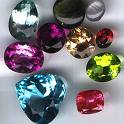Friday, February 19, 2010
Color is the most impressive and attractive feature of gemstones. The color of any material is the result of the nature of light itself. Daylight, often termed as white light, is actually a mixture of different colors of light. When light passes through a material, some of them may be absorbed, while the rest passes through. The part which is not absorbed reaches the eye as white light minus the absorbed colors. A ruby appears red because it absorbs all the other colors of white light - blue, yellow, green, etc. – other than red.
The same material can exhibit various different colors. For example ruby and sapphire have the same chemical composition, but they exhibit different colors. Though the same gemstone can occur in many different colors: sapphires show different shades of blue and pink and "fancy sapphires" exhibit a whole range of other colors from yellow to orange-pink, the latter called "Padparadscha sapphire".
This difference in color depends on the atomic structure of the stone. Although the different stones have the same chemical composition formally, they are not exactly the same. Every now and then an atom is completely replaced by a totally different atom. These so called impurities are enough to absorb certain colors and leave the other colors unaffected.
For an example: beryl, which is colorless in its pure mineral form, becomes emerald with chromium impurities. If you add manganese instead of chromium, it becomes pink morganite. Added with iron, it becomes aquamarine. Some gemstone treatments make use of these facts thus changing the color of the gem.
The same material can exhibit various different colors. For example ruby and sapphire have the same chemical composition, but they exhibit different colors. Though the same gemstone can occur in many different colors: sapphires show different shades of blue and pink and "fancy sapphires" exhibit a whole range of other colors from yellow to orange-pink, the latter called "Padparadscha sapphire".
For an example: beryl, which is colorless in its pure mineral form, becomes emerald with chromium impurities. If you add manganese instead of chromium, it becomes pink morganite. Added with iron, it becomes aquamarine. Some gemstone treatments make use of these facts thus changing the color of the gem.
Labels: Color factors
posted by Tamil Nadu ,Tamilnadu Government,Places,Wild Life,Hill Stations,Temples,Sports,Accomodation,Cusine,Fine Art @ 12:43 AM
permanent link
| Post a Comment |
![]()




0 Comments:
Post a Comment
<< Home